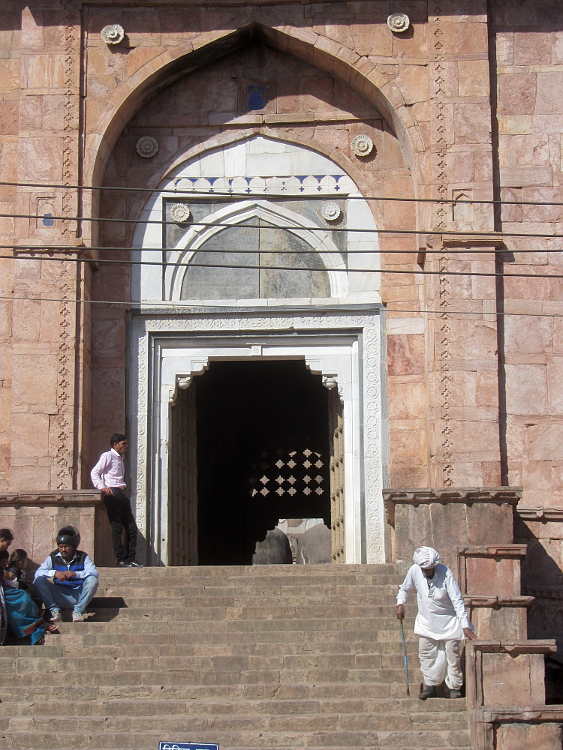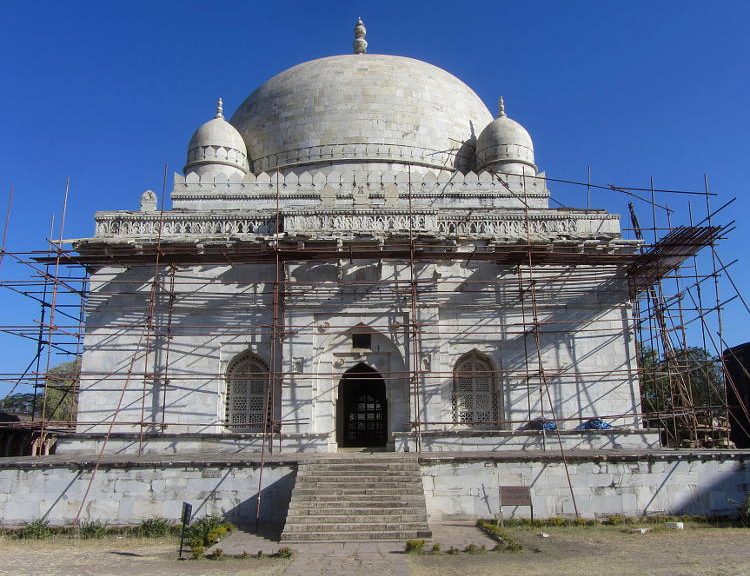
Mandu
So I emerged from the tortuous 14 hour overnight bus trip in Indore. Although the bus disgorged its passengers in an unremarkable side street, a helpful autorickshaw driver was immediately on hand to take me to the Gangwal bus station where I could get a bus to Dhar and from there another bus to Mandu. I arrived at Gangwal just in time to be ushered onto the Dhar bus which was due to depart almost immediately. However, I did manage to get a welcome breakfast of chaat and chai to take with me.
One and a half hours from Indore we arrived at Dhar and then I was led onto another bus to my final destination – Mandu which would take a further one and a half hours. Although the landscape was fairly similar to Eastern Madhya Pradesh being pretty much dry and dusty, as we were over 600kms west, the people were different, especially the men and what they were wearing. We were close to the Rajasthan and Gujarat borders so plenty wore turbans and dhotis.
Mandu is perched on a 20-sq-km plateau in the broad plains of Malwa. It is separated from the main plain by a deep ravine which encircles it on three sides, so it has always been seen as an effective defensive position. Although it gained prominence in the 10th and 11th centuries, it really only achieved fame in the 14th century when it was taken over by the Sultan of Delhi which was then followed by the so called golden period of the Sultans of Malwa between 1405 and 1531. In that time they transfered the capital of Malwa from Dhar to Mandu and built the palaces and mausoleums that can be seen today. The Malwa Sultanate collapsed in 1531 and the province passed to the Gujarat Sultanate, then the Mughals by the 1560s and finally to the Marathas in the 1730s. Mandu lapsed into ruin when it was abandoned in favour of Dhar in the 18th century. As it was abandoned and not rebuilt most of the ruins are still standing, some have been reconstructed while others lie overgrown in the now totally rural landscape.
There are four main groups of ruins, with others dotted all over the landscape. The so-called Royal Enclave is the most famous and has been the most restored; the Mandu village group, as Mandu is now no more than a small village; the Sagar Talao group a few kilometres south and the Rewa Kund group, further south still, with great views over the plains of Malwa to the holy river Narmada. However, first things first. I’d just arrived at the village bus stop so I needed somewhere to stay. Although there are a few “Indian style” resorts or rest houses around town, mainly provided by the government, I decided to stay at the only place in the heart of the village, which was also part of the Hindu temple: the Rama Guest House. Although basic, and very cheap (300Rs), the rooms were spacious and clean and situated around a pleasant courtyard.








Suitably refreshed by a cold shower and a couple of samosas from the stall in the village, I headed off to do my first sightseeing. It is only about 20 mins walk to the “Royal Enclosure” and to probably the most famous and impressive of Mandu’s monuments. It was here I was also reintroduced to the archaelogical survey of India’s new prices. Over the last year or two, the entry fees to all of India’s historical monuments have doubled. Having said that, I don’t think they had moved much in the years previously because the original price (100Rs for foreigners) to the Royal Enclosure was carved into the entrance plaque many years ago. Not something that could easily be changed and indeed the new price (200Rs) was simply scrawled over it in marker pen.
The most famous building in Mandu is the Jahaz Mahal, the so called “ship palace” because it is much longer than it is wide and it sits between 2 bodies of water looking, supposedly, like a ship. It was certainly a palace and said to have had a harem of 15,000 maidens. Either way, there are great views from the upper storey which is adorned with pavilions, domes and turrets. This is just one of many buildings nearby. Another is the Hindola Mahal another large and impressive building. Somewhat hidden away is Dilawar Khan’s mosque which is the oldest building still standing in Mandu dating from 1405. It is obviously a mosque but much of the detailing is distinctly Hindu in style – with rich ornamentation of columns and doors – a feature often found in the earliest indo-muslim architecture of the area. Although I don’t have photos, near these main buildings are many others whose function is not known although there are some interesting underground passages presumably used during the searing heat of summer. Also nearby is the hamman in the ceiling of which beautiful stars were cut for light.









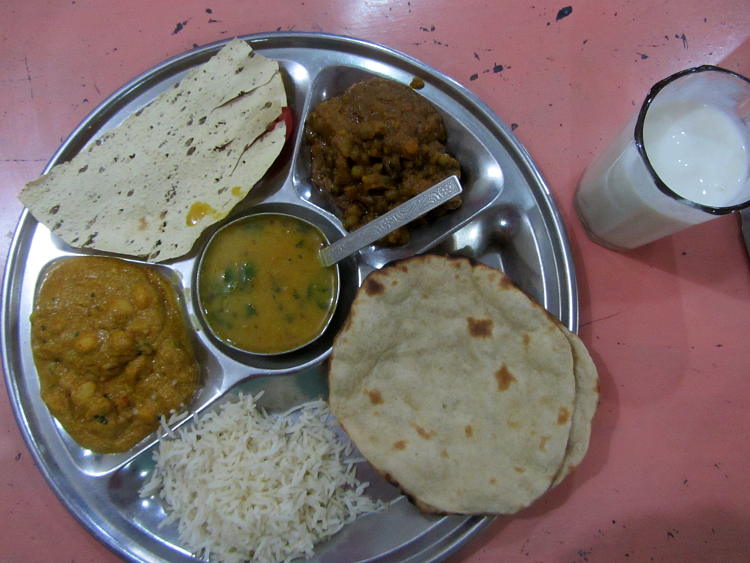
That night I dined at the only restaurant in the village, the Shivati and had the ubiquitous thali, of course, but it was pretty good. I think it was a vegetarian place but can’t be sure. There were a couple of other restaurants but as it was low season they were closed. High season is wet season here! The only problem I had in Mandu was getting the internet. There was only one small shop that provided it and only sporadically. Perhaps I shouldn’t have been surprised in such a small place but I was. Wifi is available almost everywhere in India nowadays.
Day two
The following day was market day but surprisingly the market didn’t get going until later in the afternoon so I had all morning to explore the village group of monuments. In fact there are only three. The main one is the Jami Masjid – the Friday mosque. It is said the builders had designed it after the great mosque in Damascus but I can see no resemblance whatsoever. But what the Damascus mosque has in its size and grandeur, the Mandu mosque has a richness and variety of design but also simplicity which is equally pleasing. Behind the mosque is the tomb of the sultan who initiated the building of the mosque, Hoshang Shah. Clad in marble, it is said to have at least in part inspired the design of the Taj Mahal and in fact there is an inscription to record the visit of Shah Jehan and one of his architects who was closely involved in the building of the Taj. Interestingly renovation work was going on while I was there and I could see a number of marble slabs nearby which were being carved and readied to be added to the building which was covered in scaffolding. Opposite the Jami Masjid in the centre of the village is the third of the monuments, the Ashrafi Mahal. It was meant to be the biggest and boldest building in Mandu but unfortunately the standard of engineering work did not match the ambition and a lot of the building collapsed shortly after it was built. However, it does provide a great place to admire the mosque opposite which still is in great condition.

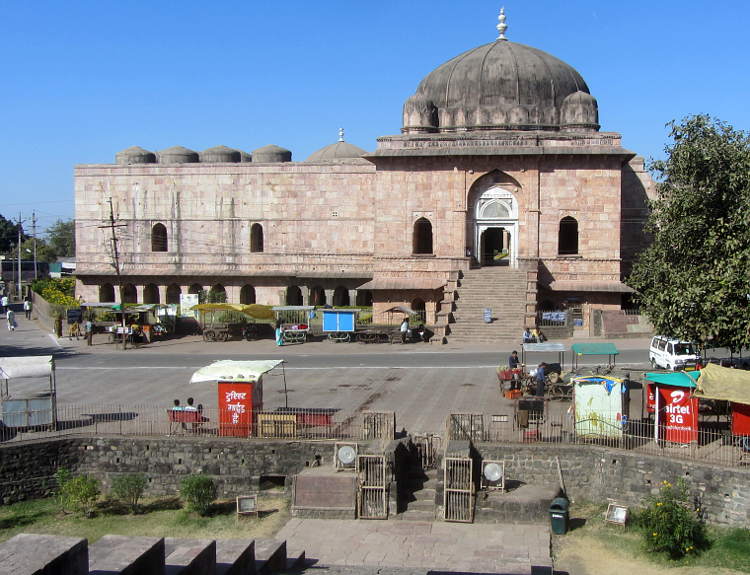








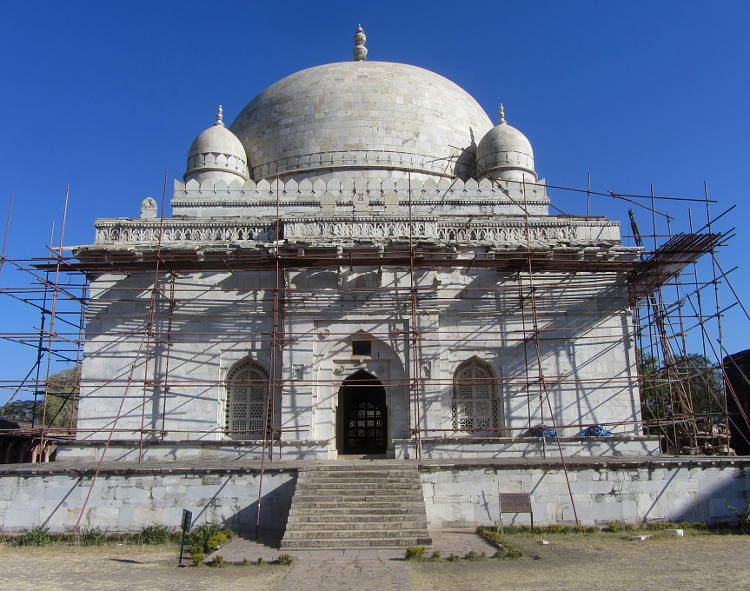


Market Day
I had been told it was an adivasi tribal market, much like I had seen further south in the Bastar region of India. I identified huge piles of dried mahuwa flowers from which they make a potent liquor but I certainly didn’t see any adivasi-looking people or groups quaffing this alcoholic liquor which I had seen before. Having said that, I enjoy markets of any description and there was plenty of interest.













On yer bike
For my last full day in Mandu I hired a bicycle and headed a bit further afield. A few kms south of Mandu village is another group of monuments, mainly mausoleums, known as the Sagar Talao group as they are very near the Talao Tank, or reservoir. The first one here is the tomb of Darya Khan. It’s a very impressive building but Darya Khan who lies here was only a minor character in Mandu, employed in the court of Sultan Mahmud II between 1510 and 1526. A little further on is the most important building in the area, the Malik Mughith Mosque built in 1432. Like the Mosque of Dilawar Khan it consists of a central court enclosed by colonnades, one aisle deep, on all sides except in the west where it is four aisles deep. There are also a few pillars highly inscribed and no doubt taken from earlier Hindu buildings. Not far from here is the impressive Dai Ki Chhoti Bahen ka Mahal which is actually associated with a lady, possibly sister, of the wet nurse of one of the princes of Mandu. Although formerly her palace it now also has her tomb. Apparently a not uncommon occurrence in these parts. Similarly the nearby Dai ka Mahal is a palace turned mausoleum which also has a small mosque attached.



















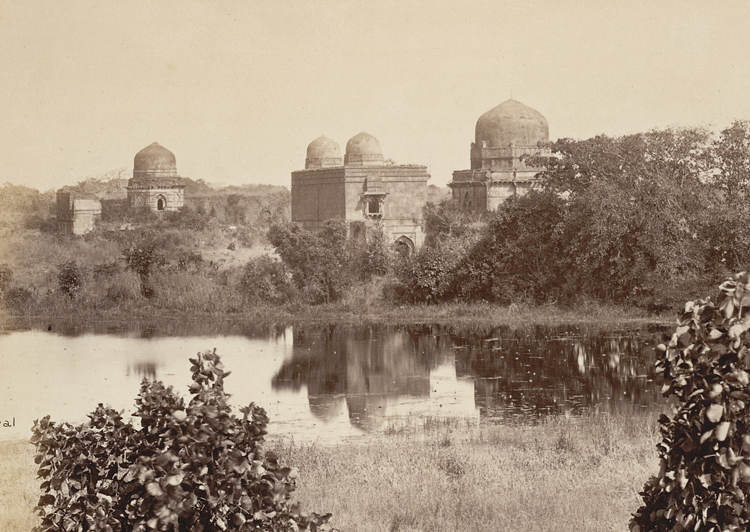
Although only lightly populated the whole area is cultivated, I think with wheat and the like, and so beyond the Sagar Talao the road passes mainly agricultural land until we reach almost the end of the plateau where we find the very impressive Palace of Baz Bahadur who was the last independent ruler of Mandu. His palace was constructed in 1509. The main portion of the palace that remains consists of a spacious open court with halls and rooms leading off. There are also pools of water and spacious terraces which give views out over the plains below. Further to the south of the palace on the lofty crest of a hill you can see the pavilion associated with the name Rupamati. Apparently she was a beautiful Hindu singer and Baz Bahadur built it for her so that she could gaze down at the distant glint of the sacred Narmada river. From here it wasn’t too far to my final destination, the Nil Kanth Palace. It stands at the head of a huge ravine which also looks south to the Narmada river. It is an Islamic building but was built on an earlier Shiva shrine and in fact it has now been reclaimed as a Hindu temple and is used as a place of worship. A tiny stream trickles out of the rock here and over a sacred lingam where I saw people giving offerings.
The following day I came back to this part of the plateau but only because I was headed south to my next destination – the pilgrimage town of Maheshwar which lies on the Narmada River. My final views of Mandu were as I passed the ruined Songarh Fort and the associated Tarapur gate, one of 12 which guarded the approaches to this enigmatic and historic hill top fort.











More photos from my trip to Mandu
Map of the journey:
For further information on Mandu:
Mark Moxon’s Travel Writing: Mandu
Rangan Datta, travel writer and photographer: Mandu
TravelLenz: Mandu, a lost corner of the heart
British library, old photos of Mandu most taken in 1902
Hand of colors, Poetry in stone
